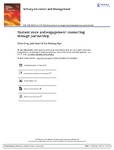Student voice and engagement: connecting through partnership
| dc.contributor.author | Swain, J | |
| dc.contributor.author | Gray, C | |
| dc.contributor.author | Rodway-Dyer, S | |
| dc.date.accessioned | 2018-08-24T08:39:03Z | |
| dc.date.available | 2018-08-24T08:39:03Z | |
| dc.date.issued | 2012 | |
| dc.identifier.uri | http://hdl.handle.net/10026.1/12191 | |
| dc.description.abstract |
This paper draws on research conducted across an English higher education partnership to investigate the ways in which student voice was engaged in further education colleges offering university awards through partnership arrangements. Such collaborations are characterised by the marginal presence of higher education students in an environment that is dominated by further education structures, culture and practice. This provides challenges for both colleges and universities in developing higher education student identity and appropriate mechanisms of student engagement that comply with expectations within the higher education sector but also recognise the contextual situation of students within the college environment. It is argued that student partnership collaboration can be a positive driver in an increasingly marketised global environment, where student voice and feedback mechanisms are at the forefront of quality assessments and institutional reputation. An ideal types framework is suggested as a heuristic device for the evaluation of college strategies of engagement. | en_US |
| dc.description.sponsorship | TFAS | en_US |
| dc.language.iso | en | |
| dc.publisher | University of Plymouth | en |
| dc.subject | student experience; higher education in further education; feedback; student identity; ideal types | en_US |
| dc.title | Student voice and engagement: connecting through partnership | en_US |
| dc.type | Report | en_US |
| plymouth.date-start | 2011-2012 | en_US |


